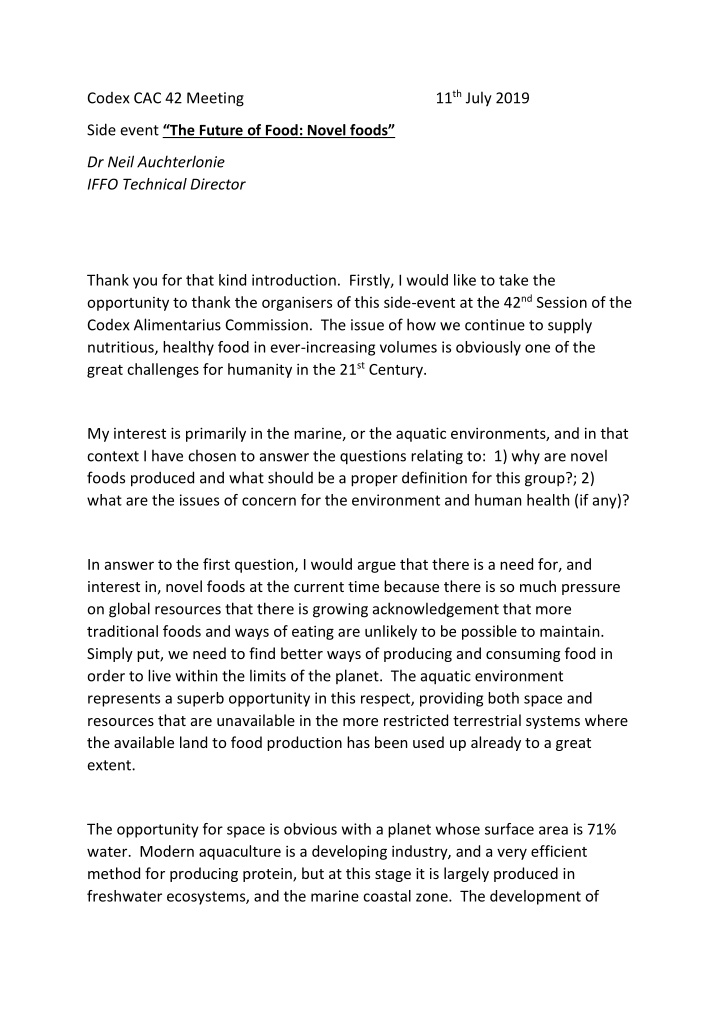



11 th July 2019 Codex CAC 42 Meeting Side event “The Future of Food: Novel foods” Dr Neil Auchterlonie IFFO Technical Director Thank you for that kind introduction. Firstly, I would like to take the opportunity to thank the organisers of this side-event at the 42 nd Session of the Codex Alimentarius Commission. The issue of how we continue to supply nutritious, healthy food in ever-increasing volumes is obviously one of the great challenges for humanity in the 21 st Century. My interest is primarily in the marine, or the aquatic environments, and in that context I have chosen to answer the questions relating to: 1) why are novel foods produced and what should be a proper definition for this group?; 2) what are the issues of concern for the environment and human health (if any)? In answer to the first question, I would argue that there is a need for, and interest in, novel foods at the current time because there is so much pressure on global resources that there is growing acknowledgement that more traditional foods and ways of eating are unlikely to be possible to maintain. Simply put, we need to find better ways of producing and consuming food in order to live within the limits of the planet. The aquatic environment represents a superb opportunity in this respect, providing both space and resources that are unavailable in the more restricted terrestrial systems where the available land to food production has been used up already to a great extent. The opportunity for space is obvious with a planet whose surface area is 71% water. Modern aquaculture is a developing industry, and a very efficient method for producing protein, but at this stage it is largely produced in freshwater ecosystems, and the marine coastal zone. The development of
offshore production systems is going to be important to be able to utilize the space that is available to perform these operations. As to what is a proper definition of this group, my suggestion is that the term “novel” is dropped, and we just call these materials “food”. Novel food carries the connotations of being untested and unknown, and those are traits that very few are going to be happy to endorse when it comes to eating! Arguably, food that has already been eaten for centuries by one culture, could be regarded as “novel” by another, yet it is far from novel according to the definitions that we are used to. In relation to the second question, that of concerns for the environment and human health, then it is clear that we need – increasingly – to be producing food with a continually decreasing environmental footprint in an effort to improve the production of protein relative to environmental impact. Again aquaculture systems are extraordinarily efficient with high productivity in unfed species such as bivalve molluscs (oysters, mussels) and seaweeds, and - in fed species - excellent feed conversion ratios, and a very impressive production level per unit area (largely drawing on the fact that these are systems that operate in 3-D). As raw material for food, and animal feed, contrary to the premonitions of doom, we still have stocks of fish in the oceans that are being harvested at levels well below maximum sustainable yield. Obvious examples are the mesopelagic fish species, krill, and other zooplankton. There is still more protein to be sourced in this manner, although it – clearly - needs to be done in a well-managed manner that avoids any possibility of over-exploitation. Data, science, and effective management and enforcement are key in making appropriate use of these resources. Another obvious advantage of aquatic-derived foods is the healthy and nutritious nature of the material. It is usually highly digestible and often contains an impressive array of micronutrients, of which the long chain omega- 3 fatty acids are but one example. Many of these are important for, if not
crucial to, human health and nutritionally there is much value to be gained from focusing on a seafood diet as we know from populations around the world that are high per capita consumers. A priority for novel food production must be food safety. Wherever, and however, the food is produced in must be produced in a manner that provides as safe nutritious product for the consumer. As part of this, and as we are aware, the environment does have some legacy issues with anthropogenic pollutants, and new production methods need to minimise the risk of carryover as far as possible in the production of new food materials. Finally, we are asked “how can we work together on this cross - cutting issue”? in response I have to say that we need to take the best practice from industry, the best innovation from science, and the best regulatory approaches from government in order to facilitate strategic planning of the novel food industry development and pave the way towards the growth of new food production sectors wherever they are located. Utilizing the expertise of individuals across a multitude of different disciplines will provide the best chance for success of new developments.
Recommend
More recommend